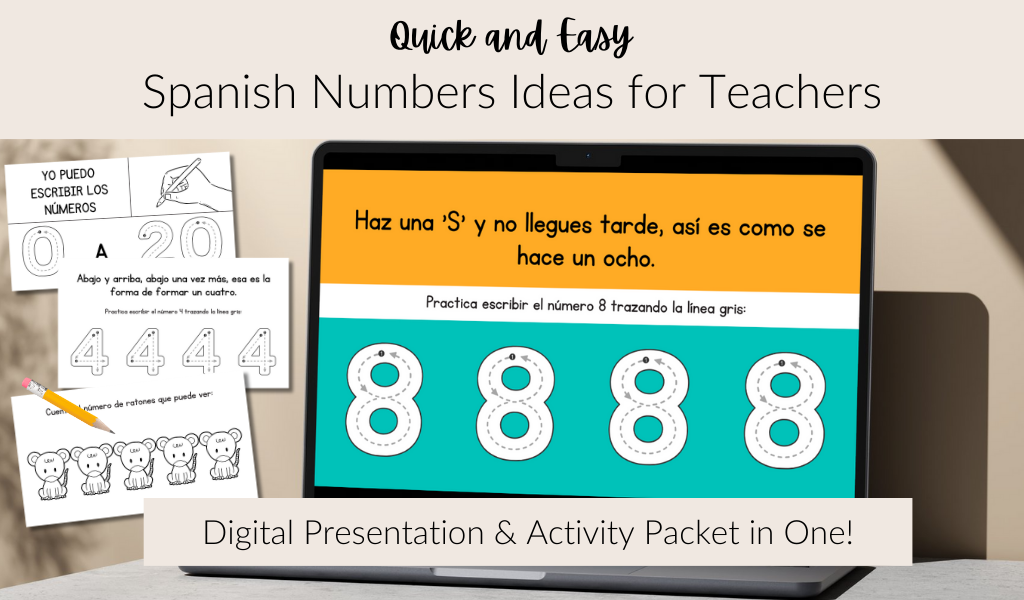When it comes to teaching a language, a balance between structured learning and creativity is essential. That’s where closed and open activities come into play. These two types of exercises are the bread and butter of language learning, giving students the structure they need while also letting them flex their language muscles in real-world scenarios.
If you’re thinking, “Okay, but how do I get this balance right in my classroom?”—don’t worry! We’re about to dive into what closed and open activities are, how to use them well (and avoid those cringe-worthy mistakes), and how the Spanish Digital and Printable Practicing Writing, Counting, and Pronouncing Numbers 0-20 resource perfectly blends these two approaches so you can easily start incorporating this blended strategy into your Spanish class.
Closed vs. Open Activities: What's the Deal?
Closed activities are those structured, predictable tasks where students know what the goal is and how to get there. Think fill-in-the-blanks, matching exercises, or multiple-choice questions. These activities help reinforce grammar rules, vocabulary, and pronunciation. They’re like the training wheels of language learning—giving students a safe, structured environment to practice.
Open activities, on the other hand, are all about creativity and flexibility. Here, there’s no single “right” answer. Conversations, role-plays, or debates fall into this category, giving students the freedom to explore language use in authentic, less predictable settings. Open activities encourage fluency and confidence as students engage with language in a more real-world context.
Example Time! 🚀
Closed Activity Example:
You teach students Spanish numbers 1-20, then ask them to complete a worksheet matching each number with its corresponding word in Spanish. There’s only one correct answer for each, keeping it straightforward.
Open Activity Example:
Have students pair up and ask each other how old they are using “¿Cuántos hay?” They can answer with a number from the list, but the conversation might flow in different directions—maybe they start talking about their favorite numbers or desserts!
Done Well vs. Done…Not So Well
Done Well:
A successful closed activity is one where students feel supported. You provide clear instructions, they practice, and you give feedback. After they complete the task, you make sure to offer time for reflection and questions.
For an open activity to shine, students need the freedom to experiment with language, but they should also feel supported. Circulate the room, offer help when needed, but mostly let them take the reins. This creates a low-stress environment where making mistakes is part of the process.
Done Poorly:
A poorly executed closed activity might feel like busywork—students complete it mechanically without really understanding the why behind it. Meanwhile, an open activity can become a chaotic free-for-all if students don’t have the vocabulary or structure to succeed.
Do’s and Don’ts for Closed and Open Activities
Do’s:
- Start with closed activities to introduce new material.
- Transition to open activities that encourage creativity.
- Use closed activities to assess specific skills.
- Scaffold open activities with prompts or sentence frames.
- Encourage collaboration during open activities to build confidence.
Don’ts:
- Don’t rely solely on closed activities—they can get dull without open-ended practice.
- Don’t jump into open activities too early—build a strong foundation first.
- Don’t skip feedback—closed activities need reflection time.
- Don’t let open activities become too unstructured—students still need some guidance.
Get Your Resource: Spanish Interactive Counting & Tracing Numbers 0-20: A Complete Resource
Spanish Digital and Printable Practicing Writing, Counting, and Pronouncing Numbers 0-20
This is where the magic happens! The Spanish Digital and Printable Practicing Writing, Counting, and Pronouncing Numbers 0-20 resource is a fantastic blend of both closed and open activities. Here’s why you’ll love it:
- Digital Presentation: An interactive slideshow that walks students through counting, writing, and pronouncing numbers.
- Printable Flashcards: Perfect for quick closed activities like matching or open-ended games like “Number Bingo.”
- Individual Workbooks: Structured, closed activities for practicing number tracing and writing.
How to Use This Resource with Closed and Open Activities
Closed Activity – Number Tracing and Writing:
Start by having students use the workbooks to trace and write numbers. This closed task helps them practice pronunciation and recognition in a structured setting.
Open Activity – Classroom Conversations:
Once students feel confident with numbers, have them pair up and ask each other, “¿Cuántos hay?” This open-ended conversation allows them to apply what they’ve learned in a real-world scenario, giving them the chance to practice fluency.
Closed Activity – Flashcard Drills:
Use the printable flashcards to review numbers in a quick and structured way. This could be a teacher-led activity or done in small groups to reinforce number recognition.
Open Activity – Number Jumping Game:
Here’s where it gets fun! Call out numbers, and students jump to the corresponding number on a number line. This open-ended game lets them move while practicing their Spanish numbers.
The Gist of it All
Both closed and open activities are essential for a well-rounded classroom. Closed activities provide structure and ensure students grasp the basics, while open activities give them the freedom to experiment and build fluency. The Spanish Digital and Printable Practicing Writing, Counting, and Pronouncing Numbers 0-20 resource offers the perfect blend of both, helping your students master foundational skills while having fun and engaging in meaningful conversation.
Looking for more numbers? Check out the full Spanish Journey set!
Spanish Journey with Los Números 1-5 Digital Presentation
Spanish Journey with Los Números 1-5 Independent Activity Packet
Spanish Journey with Numbers 6-10 Digital Presentation
Spanish Journey with Los Números 6-10 Independent Activity Packet
Spanish Journey with Numbers 11-15 Digital Presentation
Spanish Journey with Números 11-15 Independent Activity Packet
Spanish Journey with Numbers 16-20 Digital Presentation
Spanish Interactive Counting & Tracing Numbers 0-20: A Complete Resource

Resources
Brown, H. D. (2007). Principles of Language Learning and Teaching. Pearson Education.
Ellis, R. (2009). Task-based Language Learning and Teaching. Oxford University Press.
Richards, J. C. (2006). Communicative Language Teaching Today. Cambridge University Press.




